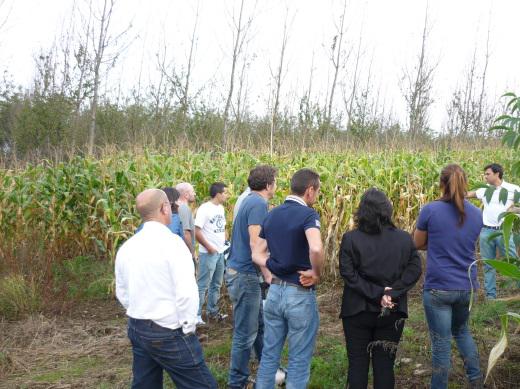
Silvoarable Systeme in Spanien
Beschreibung des Systems
In Galizien, im Nordwesten Spaniens, unternimmt die “Bosques Naturales” Firma Experimente mit Walnuss (Juglans spp) Klonen und Mais (Zea mays).
Das erste Stakeholder Treffen
Ein erstes Treffen der Interessenten mit 14 Teilnehmer wurde am 21. Oktober 2014 abgehalten. Die gewerblichen Möglichkeiten, die Originalität und das Interesse, die Durchführbarkeit des Projekts, die Vielfalt der Produkte sowie die allgemeinen ökologischen Vorteile wurden als positive Aspekte des Silvoarablen Systems erkannt. Zu den negativen Aspekten gehört die Komplexität der Arbeit, Arbeits- und Führungskosten und Verluste aufgrund von Wildtieren. Für mögliche Forschungsthemen wurden die Integration von Bäumen, Mais und Medizinalpflanzen sowie die Probleme des Baumschutzes vor Tieren identifiziert.
Falls Sie mehr über die Aktivitäten dieser Gruppe wissen möchten, kontaktieren Sie bitte Prof. María Rosa Mosquera Losada (mrosa.mosquera.losada@usc.es).
Laden Sie den ersten Bericht der Interessensgruppe runter
Laden Sie den ersten Forschungs- und Entwicklungsbericht runter
Ein Forschungsprotokol wurde von der Interessensgemeinschaft erarbeitet, welches sich auf das Wachstum von Getreide innerhalb von hochwertigen Walnussplantagen (welche ursprünglich in Arbeitspacket 2 rapportiert wurde) in der Nähe von Toledo in zentral Spanien fokussiert, wurde im März 2015 veröffentlicht. Ein Forschungsprotokol über den Anbau von Arzneipflanzen und Mais zwischen Wildbeeren in Galizien wurde ebenfalls im März 2015 veröffentlicht.
Laden Sie die Systembeschreibung runter
Ein Forschungsupdate über die Getreideproduktion unter Walnussbäumen (welche für die Produktion von Qualitätsholz genutzt werden) in zentral Spanien wurde im Januar 2016 veröffentlicht.
Lessons learnt
María Guadalupe Arenas-Corraliza, María Lourdes López-Díaz and Gerardo Moreno have completed a lessons learnt report describing the details of a comprehensive set of measurements looking at the interactions between growing walnut trees and wheat and barley crops in Mediterranean Spain.
A shading experiment demonstrated that barley and wheat yields in Mediterranean Spain could be increased with partial or 50% shade, compared to yields in full sunlight. Under some particularly dry and hot years, when the yield of the monoculture barley crop was particularly low, growing the barley within the trees increased barley yields. The effect on barley yields was more positive than that on wheat yields, because the barley crop can complete much of its development before significant leaf growth on the walnut trees. By contrast in cooler and wetter seasons, the highest barley and wheat yields were obtained from the monoculture crop. Measurement of tree growth, also indicated that the cereals reduced tree growth; it is possible that this could be prevented through the use of irrigation. In summary, the results demonstrate that barley yields in particularly dry and hot years can be maintained through the use of tree cover.
Lessons learnt
Rosa Mosquera-Losada and colleagues at the University of Santiago de Compostela have produced two reports. The first describes the responses of maize intercropped between wild cherry trees (Prunus avium L). In an experiment where the trees had been planted in 2008 at interrow spacings of 1.25, 2.5 and 5 m, the total dry biomass produced by intercropped maize (per cropped area) of 4.4 to 14.0 t/ha, was lower than the approximately 25 t/ha of biomass produced in plots without trees due to the spaced occupied by the tree rows. Maize has a “C4” photosynthetic pathway and can respond positively to high light levels. There is a recommendation to test the shade responses of maize varieties to increase production under shade.
The second report focuses on the response of two medicinal crops (Melissa officinalis L. and Mentha x piperita L.) intercropped between wild cherry trees. The yields, although low at 0.3-0.7 t/ha, are similar to those obtained in other studies in open sites. Hence they appear suitable agroforestry crops. The concentration of Rosmarinic acid in the leaves of Melissa officinalis was higher when the crop was grown under a high density, rather than a lower density, of trees. This may be explained because the concentration of Rosamarinic acid is higher before flowering and tree shade delays flowering.